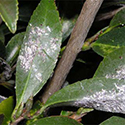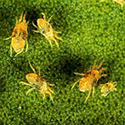Camellia Pests and Problems
Camellias are a favorite cool-season bloomer, but while you are enjoying their beauty keep an eye out for signs of damage.

This is a condensed version of the UF/IFAS publication, Key Plant, Key Pests: Camellia, covering some of the common diseases, pests, and deficiencies that afflict camellia plants.
Diseases

Juanita Popenoe, UF/IFAS
Algal leaf spot (Cephaleuros virescens) shows up as silvery-grey, green, or tan raised spots or blotches with green margins that are located on leaves. Heavily infected plants may experience premature yellowing and leaf loss. Abundant moisture, high temperatures, and direct sunlight favor algal leaf spot infections which will be most damaging on slow-growing, already weakened plants. There are no fungicides recommended to treat algal leaf spot; however, you can use selective pruning to increase air circulation and remove heavily infected leaves.

Dieback, twig blight, or canker (Colletotrichum gloeosporioides (asexual stage, Glomerella cingulate) diseases are noticed when new, succulent growth in the spring wilts and leaves drop. Entire twigs and shoots may turn brown and die as temperatures increase. Cankers form on older wood at the base of dead twigs. Persistent active cankers can last for two years on woody stems, providing inoculum that will enter wounds and kill cuttings. This disease is most severe in warm, humid conditions and a wound or natural opening is required for a plant to become infected; leaf scars are the most common point of entry. The strain of Glomerella that infects camellia doesn’t attack other plants, but it will attack all species of camellia except C. sinensis. Splashing water can spread the disease, so it’s best to carefully irrigate if infection is present. When pruning out diseased areas, prune 6 inches below visibly affected parts. Be sure to disinfect pruning tools regularly during pruning. You can use a chemical control in the spring when the old leaves are shedding; one fungicide application at this time is usually sufficient.

University of Georgia, Bugwood.org
The aptly named flower blight (Ciborinia camelliae) affects flowers— and only flowers—at various stages of development. Irregular tan to light brown spots first appear on petals of expanding flowers and progressively turn the entire flower brown. The fungus is able to survive from one season to the next in the soil. You can distinguish flower blight from other types of flower damage by the growth of the brown spots, a netted appearance with the veins darker than the surrounding tissue, and by the scattered appearance of the blighted flowers. This disease most severely affects C. japonica because spores are released at the same time this species develops flowers. Chemical treatments are only used when there is a history of severe infection and should be targeted to the ground around and under plants in the fall prior to flowering. A second application is often required.

Juanita Popenoe, UF/IFAS
Above-ground symptoms of wet root rot diseases (Phytophthora and Pythium spp.) are poor plant growth, thinning of the foliage, and yellowing of the leaves, with the oldest foliage being affected first. This disease is triggered by periods of excessive soil moisture. Conditions that favor disease development include planting too deep, poor drainage, shallow rooting, and poor water management. When buying plants, be sure to check the roots before planting into your landscape. Provide plants with adequate drainage and reduce irrigation. You can apply labeled fungicides if the problem is diagnosed early and cultural problems are corrected.

The first symptoms of root rot (Phytophthora, Pythium spp; Rhizoctonia solani) that are noticed are usually in the foliage, which turns light green (somewhat like a nutrient deficiency), then becomes yellow, wilts, and eventually falls off. Infected roots are discolored brown and rotten with no feeder roots, and occasionally cankers on the lower stem. Plants can become stunted and die quickly if they are young with a limited root system, or slowly decline if older. Infection can occur whenever conditions (moderate temperatures and saturated soils) are right, but symptoms may not be noticed until hot weather when the lack of roots is more limiting to the plant’s health.
Pests

Aphids have small, pear-shaped bodies with paired cornicles in rear and they may or may not have wings. Aphids cluster and feed on new growth — flowers, stems, and leaves. Sooty mold grows on honeydew excreted by the aphids. Aphids occur in the spring and throughout the growing season. High aphid populations may be treated with insecticidal soaps, oils, or approved insecticides.

More than 30 species of scale are problematic for camellias, with tea scale being the most common. Variegation on the top of the leaf may be seen with severe infestations. The scale lives on the bottom of the leaf and, in severe infestations can look fuzzy in a cluster. In Florida, scales reproduce continually throughout the year, but in cooler climates, hatching often coincided with the warming spring temperatures. Pruning will allow for better coverage of chemical sprays and increases air circulation. Control with 2-3 applications of insecticidal soaps or horticultural oils timed 7-10 days apart, being sure to thoroughly cover the underside of the leaves.
Spider mites are small, eight-legged mites that are most commonly on the undersides of leaves. The upper sides of leaves infected with mites have a stippled or bronzed appearance. Southern red mites thrive in cool, moist conditions, while two-spotted mites prefer hot, dry weather. You can scout for mites by tapping branches over a white surface like a piece of paper, where they are more easily seen. Insecticidal soaps, horticultural oils, or approved miticides may be used to control mites when necessary.
Nutrient Deficiencies

Magnesium deficiency is the most common nutritional deficiency on camellias in Florida. Symptoms are more severe on the oldest leaves; severely deficient plants will drop their leaves. Leaves will appear to have broad interveinal or marginal chlorosis but are not necrotic.
Nitrogen deficiency can also be a problem for camellias in Florida. Leaves turn a uniform light-green or yellow color, most severely on the oldest leaves. As the deficiency becomes more widespread the entire plant becomes bright green or yellow and growth declines sharply.
Also on Gardening Solutions


